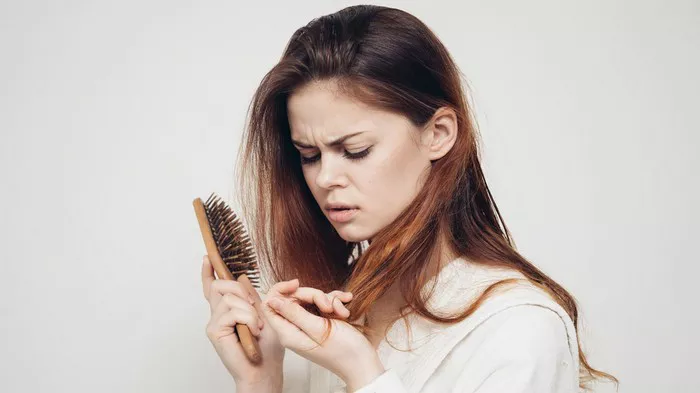Hair loss is a common concern for many people, and noticing strands of hair on your comb can be particularly alarming. However, it’s important to understand the difference between normal hair shedding and abnormal hair loss. This comprehensive guide will delve into the reasons behind hair fall during combing, how to distinguish between normal and excessive hair loss, and what steps you can take to maintain healthy hair.
Understanding Hair Growth and Shedding
Hair growth occurs in cycles, consisting of three main phases: anagen (growth phase), catagen (transitional phase), and telogen (resting phase). During the anagen phase, hair grows actively, which can last from two to seven years. The catagen phase is a short transitional period that lasts about ten days. Finally, the telogen phase is a resting period where the hair does not grow but remains attached to the follicle. After this phase, hair naturally falls out, making way for new growth.
Normal Hair Shedding
Daily Hair Loss:
On average, it is normal to lose between 50 to 100 hairs per day. This hair shedding is part of the natural hair growth cycle and is typically not noticeable unless you pay close attention.
Seasonal Shedding:
Some people may experience increased hair shedding during certain seasons, particularly in the fall and spring. This phenomenon is often related to changes in daylight and temperature.
Causes of Hair Fall While Combing
Natural Shedding:
When you comb your hair, especially after washing, you may notice more hair fall. This is often due to the natural shedding process, where loose hairs that have reached the end of their growth cycle are dislodged.
Tangled Hair:
Hair tangles can cause more strands to be pulled out when combed. If your hair is particularly prone to tangling, consider using a wide-tooth comb or a detangling spray to minimize hair breakage and loss.
Hair Texture and Length:
People with long hair or certain hair textures (e.g., curly or coily hair) might see more hair in their comb due to the length and the nature of their hair strands, which can trap more shed hair.
Abnormal Hair Loss
Excessive Shedding:
If you notice significantly more hair fall than usual, it might indicate a problem. Excessive shedding could be due to a variety of factors including stress, hormonal changes, nutritional deficiencies, or underlying medical conditions.
Alopecia:
Alopecia is a condition characterized by hair loss. There are several types, including androgenetic alopecia (pattern baldness), alopecia areata (patchy hair loss), and telogen effluvium (diffuse shedding). Each type has distinct causes and patterns of hair loss.
Medical Conditions:
Certain medical conditions, such as thyroid disorders, lupus, and polycystic ovary syndrome (PCOS), can lead to hair loss. Additionally, scalp infections and skin conditions like psoriasis and seborrheic dermatitis can affect hair health.
Factors Affecting Hair Loss
Diet and Nutrition:
A balanced diet rich in vitamins and minerals is crucial for healthy hair. Deficiencies in nutrients such as iron, zinc, and vitamins A and D can lead to hair thinning and loss.
Stress and Lifestyle:
Stress can trigger hair loss conditions such as telogen effluvium, where stress pushes a large number of hair follicles into the telogen phase. Adequate sleep, regular exercise, and stress management techniques are important for overall hair health.
Hormonal Changes:
Hormonal fluctuations during pregnancy, postpartum, menopause, and due to conditions like PCOS can affect hair growth. Birth control pills and hormone replacement therapy can also impact hair shedding.
See Also: Is Hair Fall a Sign of Early Pregnancy: What You Need To Know
Hair Care Practices:
Frequent use of heat styling tools, harsh chemical treatments, tight hairstyles, and improper hair care routines can lead to hair damage and loss. Gentle handling of hair and choosing the right products for your hair type can help reduce hair fall.
Preventing Hair Loss While Combing
Use the Right Comb:
A wide-tooth comb is gentler on the hair and can help prevent breakage and tangling. For detangling wet hair, use a comb designed specifically for that purpose to minimize damage.
Gentle Combing Techniques:
Start combing from the ends of your hair and work your way up to the roots. This method helps to detangle knots gradually and reduces the strain on hair strands.
Hair Conditioning:
Conditioners and leave-in treatments can help make hair more manageable and less prone to breakage. Deep conditioning treatments can also strengthen hair and improve its overall health.
Avoid Over-Washing:
Washing hair too frequently can strip it of natural oils, leading to dryness and breakage. Depending on your hair type, aim to wash your hair two to three times a week.
When to Seek Professional Help
If you notice sudden, excessive hair loss or bald patches, it’s important to consult a healthcare professional or a dermatologist. They can help diagnose the underlying cause and recommend appropriate treatments. Early intervention can prevent further hair loss and promote regrowth.
Conclusion
Hair fall while combing is often a normal part of the hair growth cycle. However, understanding the distinction between normal shedding and abnormal hair loss is crucial. By maintaining a healthy lifestyle, adopting gentle hair care practices, and seeking professional advice when needed, you can manage hair shedding effectively and maintain healthy, vibrant hair.


